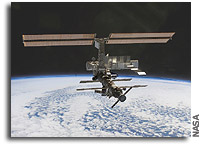NASA Space Station On-Orbit Status 12 December 2004

SpaceRef note: This NASA Headquarters internal status report, as presented here, contains additional, original material produced by SpaceRef.com (copyright © 2004) to enhance access to related status reports and NASA activities.
All ISS systems continue to function nominally, except those noted previously or below. Sunday, second weekend rest day for the crew. Ahead: Week 8 of Increment 10.
FE Sharipov completed the routine SOZh/ECLSS maintenance, including the weekly inspection of the BRPK air/liquid condensate separator apparatus. [The BRPK inspection is mostly concerned with the condensate in CWC (contingency water container) #1027 and the EDV with water transferred from the KTV nonpotable water, to check for presence of air bubbles by removing the outer container cover and looking through the backlit transparent shell.]
|
Previous Reports ISS On-orbit Status [HQ] |
Working off the Russian discretionary task list, Salizhan unstowed and checked the equipment for the European “Neurocog” experiment (still on board from Pedro Duque’s VC5 Cervantes program in October of last year), to be conducted in the near future. [The FE’s task today was to check out the status of the control application for the HALLEY hardware, stored on a PCMCIA memory card, and downlink it via OCA for checkout on the ground.]
Also on the Russian task list for Salizhan was the conclusion of the current session with the Russian “Uragan” earth-imaging program. [The FE focused his Kodak DCS760 digital camera with 800-mm lens today on the city of Vladikavkaz in nadir, along both sides of the River Terek, passes of the Main Caucasus Ridge to check on avalanche status, any oil slicks in the waters of the Caspian Sea, the city of Bombay, the cities of Beirut and Damascus in nadir, an oil refinery with off-shore terminals to the west of Bilbao, Spain, the Panama Canal, a panorama of the Andes, and other scenes of crew’s preference.]
Sharipov was also asked to return the AST spectrometer that he had installed in the DC1 on 12/6 for testing, to its stowage location in the FGB.
The crew performed their daily 2.5-hr. physical exercise program on TVIS treadmill, RED exerciser, CEVIS cycle and VELO cycle with bungee cord load trainer. Salizhan’s daily protocol currently prescribes a 1.5-hr structured set on the treadmill (today: Day 1 of a new set) and one hour on VELO.
CDR Leroy Chiao had his weekly PFC (private family conference) via S-band/audio.
Upcoming Key Events:
- Progress 15P undocking & destructive reentry — 12/22 (Eastern);
- Progress 16P launch — 12/23 (5:19pm EST);
- Progress 16P docking — 12/25 (7:10pm EST);
- EVA-12 — 1/25/05;
- Progress 16P undocking & destructive reentry — 2/27/05;
- Progress 17P launch — 2/28/05.
- EVA-13 — 3/25/05;
- Soyuz 9S undock — 4/25/05 (after 193 days on orbit, 191 days on board ISS).
|
ISS Location NOW |
CEO photography can be viewed and studied at the websites:
See also the website “Space Station Challenge” at:
To view the latest photos taken by the expedition 10 crew visit:
- http://spaceflight.nasa.gov/gallery/images/station/crew-10/ndxpage1.html at NASA’s Human Spaceflight website.
Expedition 10 Flight Crew Plans can be found at http://spaceflight.nasa.gov/station/timelines/
Previous NASA ISS On-orbit Status Reports can be found here. Previous NASA Space Station Status Reports can be found here. Previous NASA Space Shuttle Processing Status Reports can be found here. A collection of all of these reports and other materials relating to Return to Flight for the Space Shuttle fleet can be found here.
ISS Altitude History
Apogee height — Mean Altitude — Perigee height

For more on ISS orbit and worldwide ISS naked-eye visibility dates/times, see http://www.hq.nasa.gov/osf/station/viewing/issvis.html. In addition, information on International Space Station sighting opportunities can be found at http://spaceflight.nasa.gov/realdata/sightings/ on NASA’s Human Spaceflight website. The current location of the International Space Station can be found at http://science.nasa.gov/temp/StationLoc.html at NASA’s Marshall Space Flight Center. Additional satellite tracking resources can be found at http://www.spaceref.com/iss/tracking.html.









